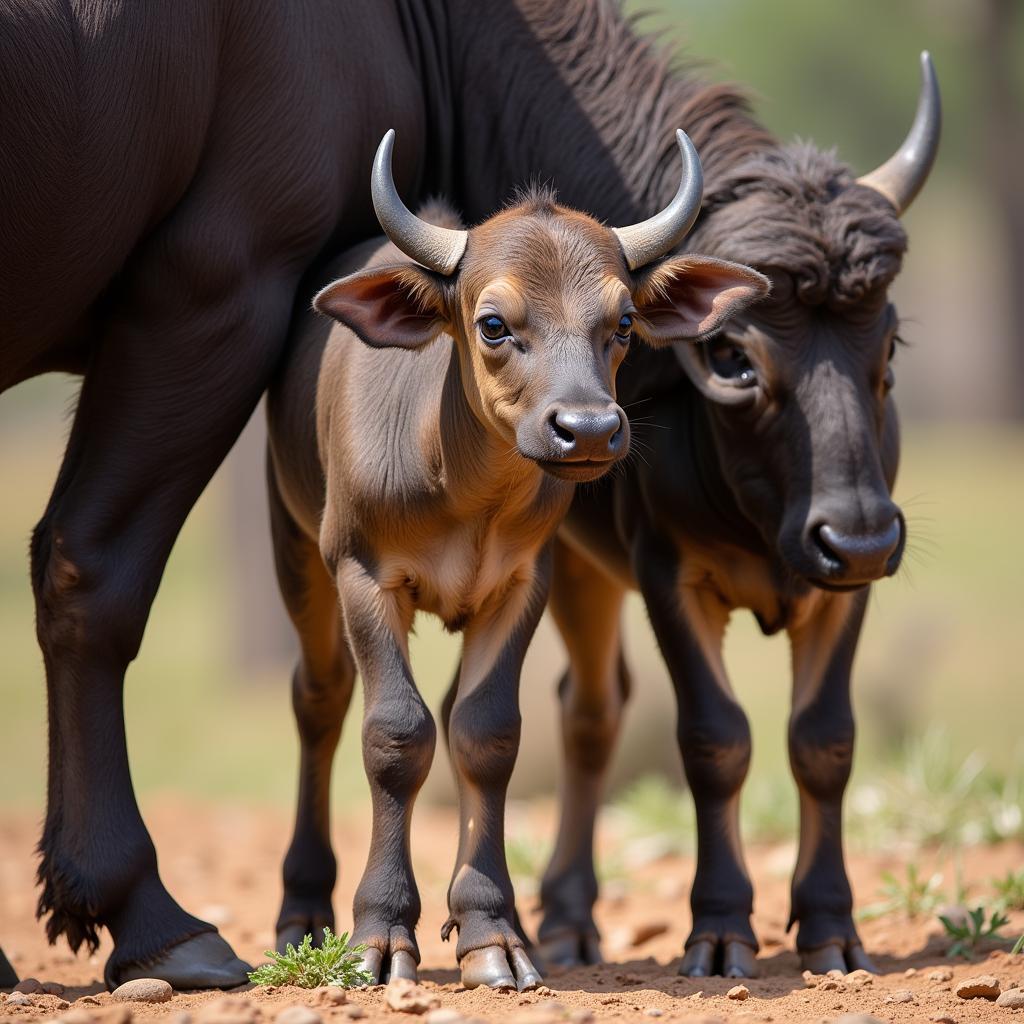Majestic African Buffalo South Africa: A Symbol of Power
The African Buffalo South Africa, a creature of immense power and presence, roams the savannas and woodlands. This article delves into the fascinating world of these iconic bovines, exploring their behavior, habitat, and the crucial role they play in the South African ecosystem. After reading this, you will have a deeper appreciation for these remarkable animals.
Unveiling the African Buffalo: Physical Characteristics and Behavior
African buffalo, scientifically known as Syncerus caffer, are formidable herbivores easily recognized by their massive horns and thick hides. Their horns, particularly in mature males, form a characteristic “boss” – a thick, fused base covering the forehead. This impressive headgear serves as a powerful weapon in confrontations with predators or rivals.
These large bovines are highly social animals, living in herds that can range from a few dozen to several hundred individuals. Within the herd, complex social hierarchies exist, with dominant males leading the group and protecting the females and young. Their social structure allows for coordinated defense against predators such as lions, leopards, and hyenas. Their collective strength and aggressive nature make them a force to be reckoned with. african buffalo south
Understanding the Buffalo’s Role in the Ecosystem
African buffalo are considered keystone species in their ecosystems. Their grazing habits influence vegetation structure, creating a mosaic of habitats that benefit other species. They also contribute to nutrient cycling through their dung, which fertilizes the soil.
Where to Encounter African Buffalo in South Africa
South Africa offers a number of excellent locations to observe these magnificent animals in their natural habitat. Kruger National Park is perhaps the most famous, with large, healthy buffalo herds roaming its vast plains. Other notable parks include Hluhluwe–iMfolozi Park, Addo Elephant National Park, and the private game reserves scattered throughout the country.  A large herd of African buffalo grazing in Kruger National Park
A large herd of African buffalo grazing in Kruger National Park
Navigating Buffalo Encounters: Safety Tips for Wildlife Viewing
While observing these powerful animals is thrilling, it’s crucial to maintain a safe distance and respect their space. african buffalo wildlife africa Never approach a buffalo on foot, and always remain inside your vehicle when in close proximity. Sudden movements or loud noises can startle them, leading to unpredictable behavior. Remember, these animals are wild and deserve our respect.
The Conservation Status of African Buffalo in South Africa
African buffalo populations in South Africa are generally considered stable, thanks to effective conservation efforts and protected areas. However, they still face threats such as habitat loss due to expanding human settlements and the risk of disease transmission from domestic cattle. southern african countries
How can we help conserve the African Buffalo?
Supporting conservation organizations working to protect their habitats and mitigate threats is crucial. Responsible tourism practices, such as choosing eco-friendly safari operators and respecting wildlife viewing guidelines, also play a vital role in ensuring the long-term survival of these magnificent creatures.
Dr. Sarah Jones, a renowned wildlife biologist specializing in African megafauna, states, “The African buffalo is a testament to the power of nature and a vital component of the South African ecosystem. Their conservation is essential for maintaining the biodiversity of the region.”
 An African buffalo calf with its mother
An African buffalo calf with its mother
Conclusion: The Enduring Legacy of the African Buffalo in South Africa
The African buffalo South Africa is more than just a powerful herbivore; it is a symbol of the wild heart of Africa. Their presence enriches the South African landscape and reminds us of the importance of preserving our planet’s biodiversity. By understanding and respecting these magnificent creatures, we can ensure their continued existence for generations to come. south african papers african elephant loxodonta africana
FAQ
-
What is the average lifespan of an African buffalo? Typically, they live for 15-20 years in the wild.
-
What do African buffalo eat? They are grazers, primarily feeding on grasses.
-
Are African buffalo dangerous? Yes, they are powerful and can be aggressive, especially when threatened.
-
How big are African buffalo? They can weigh up to 900kg and stand over 1.5 meters tall at the shoulder.
-
What are the main predators of African buffalo? Lions, leopards, crocodiles, and hyenas.
-
Where can I see African buffalo in South Africa? Kruger National Park, Hluhluwe–iMfolozi Park, and Addo Elephant National Park are good locations.
-
How many African buffalo are there in South Africa? Accurate population estimates vary, but they are considered relatively stable.
Scenarios of common questions
-
What should I do if I encounter an African buffalo while on foot? Slowly and calmly back away, avoiding direct eye contact and sudden movements.
-
Can I feed African buffalo? Never feed wild animals. It disrupts their natural behavior and can be dangerous.
-
Are there different types of African buffalo in South Africa? While all belong to the same species, there are regional variations in size and horn shape.
Further Exploration:
- Learn more about other African wildlife.
- Discover the best safari destinations in South Africa.
Need help?
For further assistance, contact us:
Phone: +255768904061
Email: kaka.mag@gmail.com
Address: Mbarali DC Mawindi, Kangaga, Tanzania.
Our customer service team is available 24/7.
